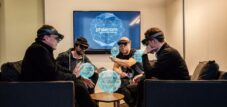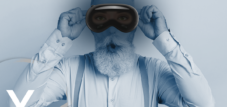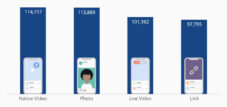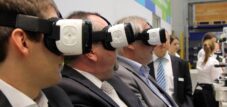Published on: July 24, 2025 / update from: July 24, 2025 – Author: Konrad Wolfenstein

Virtual Reality Smartphone app “Wist”: This is how your videos become accessible 3D memories – creative image: xpert.digital
iPhone Pro makes it possible: app transforms normal videos into immersive 3D experiences
Spatial memories: Wist app lets you walk through past moments
Imagine that you could not only watch an old video of your child's birthday or from the last vacation, but literally enter the scene and move in it. Exactly this fascinating promise makes an app called Wist, which is the way we capture and experience our past. It turns ordinary smartphone videos into walk-in, three-dimensional "spatial memories".
This is made possible by a technology that is already in many pockets: the lidar scanner of current iPhone Pro models. In combination with advanced algorithms like Gaussian Splitting, Wist not only creates a video, but a complete 3D reconstruction of a moment. This can then be continuously explored with mixed reality headsets such as the Meta Quest 3 or the Apple Vision Pro as if you are entering a personal hologram.
But Wist is more than just a technical gimmick and goes far beyond Apple's native spatial video format. While the latter provides a stereoscopic image, Wist enables real freedom of movement within the recording. This technological jump opens the door to profound questions: What does it mean for our memory if we can no longer only look at the past, but can commit? What therapeutic opportunities arise, and where do the dangers of nostalgia addiction and digital abuse lurk how they draw dark future visions à la "Black Mirror"?
In this article we immerse yourself deep into the world of spatial memories and answer the most important questions about Wist – from the technical foundations to the emotional effects to the ethical and economic aspects. It illuminates a technology that has the potential to fundamentally change our relationship to the past.
Suitable for:
- Virtual Reality: My first Metaverse in 1972 with the View-Master and further development over the 90s until today (Konrad Wolfenstein)
What is Wist in one sentence?
Wist is a smartphone app that converts conventional video recordings into walk-in 3D scenes so that users can experience their memories using augmented and mixed reality heads such as Meta Quest 3 or Apple Vision per space-filling.
Why does a single app attribute so much attention?
Because Wist makes the mass-friendly attempt for the first time to convert everyday memories into real-time holograms without users need special cameras or expensive desktop software.
What distinguishes Wist from classic 2D videos or today's Spatial video recordings on the iPhone 15 Pro?
Instead of recording only two stereoscopic camera images, Wist also raises depth data over the Lidar sensor, combines them with an exact device pose and packs everything into a reconstructed point or Gaussian splitting model, which allows the viewer to do real parallax movement.
How does Wist-CEO Andrew Mchugh define the term "spatial memory"?
As a digital reconstruction of a life situation in which one can physically enter and move freely, which supplemented established photo or video modes with room coordinates and depth.
Is this idea new?
Research fields such as Spatial Memory Assessment in VR have existed for years, but there has been no everyday consumer app that automatically converts videos into interactive 3D scenes.
Which Apple devices support the recording for Wist?
Apple devices play a central role in the absorption of Wist videos, whereby only certain iPhone models support this function. Specifically, these are all PRO and PRO-MAX generations from the iPhone 13 that are equipped with a lidar scanner. The iPhone 13 Pro is the entry-level model for Wist recordings, followed by the iPhone 14 Pro with its faster A16 CPU. The iPhone 15 Pro also offers native spatial video functions. In contrast, standard models such as the iPhone 15 cannot absorb Wist videos because they lack the required lidar scanner. The technology is therefore limited to the higher quality pro variants that have the necessary sensors.
Why does Wist put on the lidar scanner?
The scanner emits laser impulses, measures their term until reflection and thus delivers millimeter-precise deep cards that are essential for solid 3D-Re-enactment.
Does the phone's computing power also play a role?
Yes, because the app does large parts of the reconstruction pipeline locally, which requires A-Serie Socs from A15.
How does a typical recording work?
The app starts directly in the video mode; The user films a maximum of 40 s, while lidar and motion sensors collect data in sync.
What happens after the recording?
The iPhone segmented video frames, creates a point cloud from depth and pose, optimizes using Gaussian-Splitting and stores raw data for later pipeline updates.
Why are raw data important?
Future software versions can reconstruct the same scene with more advanced algorithms without the user having to film again.
How do you enter the memory?
By AR mode on the iPhone or via a dedicated mixed reality app for Quest 3 or Vision Pro, which the 3D scene places in the room as a holographic ball.
Which image rates reaches Wist on Quest 3?
Demo builds with 400,000 Gaussians create stable 72 FPS thanks to Foveated VR-Splitting grid.
Does Apple Vision Pro use the same data?
Yes; Wist exports the model as a USD-Z asset, which represents Vision Pro in its reality kit renderer, whereby Apple is switching its own foveated shading.
What is Gaussian Splatting?
A procedure that encodes every 3D rehearsal as anisotropic Gaussklocke with color; When rendering, millions of these ellipsoids are split on the screen via GPU grid.
Why does Wist choose this process instead of classic mesh?
Because it can efficiently process unstructured depth samples, delivers photorealistic soft-edged reconstructions and can be scaled in head-tracked VR.
Are there any viewing angles?
Yes. Since only a camera position is filmed, the rear views are missing; Edges can appear transparent.
How does the app minimize these hurdles?
Through ML-based inpainting diffusion models that fill holes, as well as depth superresolution based on neural networks.
How does that compare with Apple's native spatial videos?
Apple delivers stereo-RGB, but no free parallax; Wist offers freedom of movement, but sacrifices details in distant angles.
What psychological studies are there for spatial memory?
VR research shows that mixed reality contexts are the episodic memory of intensive trigger than 2D stimuli.
Can such memory areas have a therapeutic effect?
Yes; VR-based Memory Replays examine applications for coping with the trauma and senior citizens, reporting higher memory loyalty and emotional response.
Where are the scenes saved?
By default locally and in encrypted iCloud storage; Cloud processing remains optional.
Can third parties reconstruct my rooms?
Only if the user grants releases; META-Quest-Policy requires separate consent for spatial data sharing.
What risks do data protectionists see?
Misuse of high-resolution private rooms for targeting, deep pake manipulation or social engineering attacks.
Does Wist have a business model?
Freemium platform: basic account for free, premium subscription for longer clips, cloud render credits and multi-user sessions.
Who invests?
Fishing rounds from Silicon-Valley-XR funds; CEO Andrew Mchugh previously at Samsung XR design brings industry contacts.
Is there competition?
Apple itself, Insta360 hardware, third-party apps such as Spatialify, which offer higher resolutions for spatial video.
Suitable for:
What cultural narratives do such apps operate?
Series such as "Black Mirror" represent memory replays as a blessing and curse; Heise compares Wist with the episode "Eulogy", in which VR memories appear healing.
Could nostalgia become addicted?
Researchers warn of the risk of escapism when perfectly reconstructed yesterday exceeds the attraction of real present.
Are there positive visions?
Remembrance-HOLOGRATIONS could preserve historical places, family stories or cultural heritage alive and make education more interactive.
Which light situation is ideal?
Natural, uniform light; No hard shadows because Lidar affects stray light.
How long can the clip be?
Currently 40 s; Longer sequences increase the amount of data exponentially and make real-time streaming difficult.
Which motifs are particularly worthwhile?
Spatially dynamic scenes with deep grading in the area of 1 m – 4 m in front of the camera, such as birthdays or pet campaigns.
Is there an SDK?
Wist plans API access to the reconstruction pipeline to connect external XR apps.
How do you integrate Wist scenes into unity?
Using USD-Z export and a Gaussian renderer package that contains VR-optimized sorting algorithms for multi-layer splits.
Is 3DGS in mobile chipsets hardware accelerated?
Patent roadmaps from Qualcomm signal tensor cores for Gaussian-Forward-Splats, which enables 90 FPS mixed reality replays on smartphone SoC.
How could future iPhones improve the recording?
Rumors about duo-lidar arrays with a range of 10 m and variable point density are circulating, which would allow 360 ° scanning in real time.
Will AI completely close holes?
Diffusion models approach photo-consist key scores from 0.95 compared to real multi-view scans, significantly reduce shadow artifacts and texture fibrillation.
Does our relationship to the past change?
Yes. As soon as personal history is not only seen, but spatially experienced, the boundary between memory and the present shifts - with opportunities for empathy and risks of emotional flooding.
Wist shows that even consumer electronics have long been able to prepare private moments as holographic portals. The technology is fascinatingly efficient, but ethically challenging. If you use them, you should weigh up opportunities for preserving and sharing memories against data protection and addiction problems.
Suitable for:
Your global marketing and business development partner
☑️ Our business language is English or German
☑️ NEW: Correspondence in your national language!
I would be happy to serve you and my team as a personal advisor.
You can contact me by filling out the contact form or simply call me on +49 89 89 674 804 (Munich) . My email address is: wolfenstein ∂ xpert.digital
I'm looking forward to our joint project.













